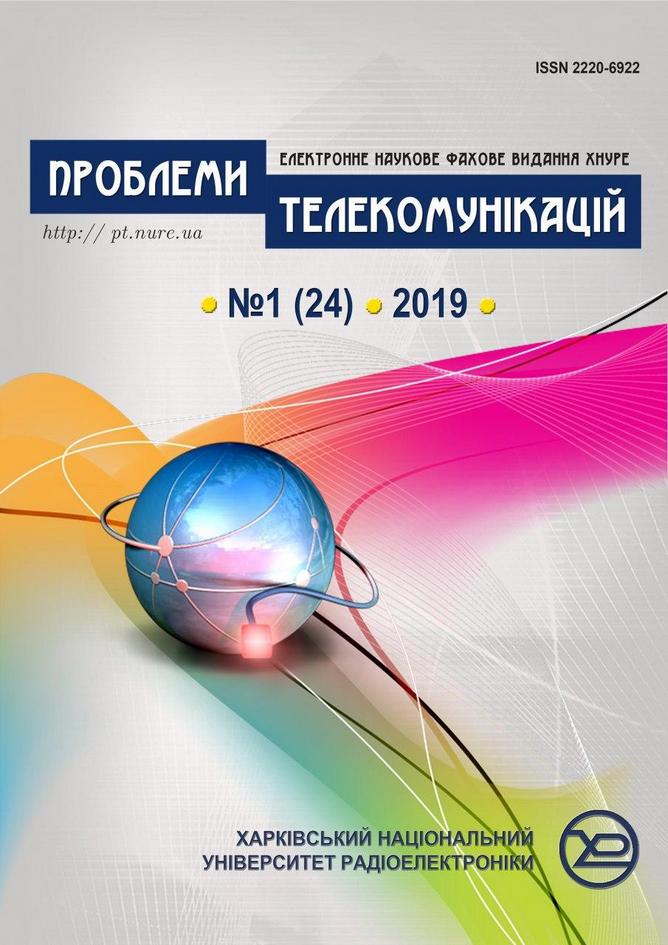The use of MIMO technology in open optical communication systems with indirect visibility to improve the reliability of information transfer
DOI:
https://doi.org/10.30837/pt.2019.1.06Keywords:
Fiber optic, Multiplexing, Laser, Radiator, MIMOAbstract
It is proposed to use MIMO technology in NLOS systems. The system operates in the optical short-wave ultraviolet range of radio waves. MIMO technology uses orthogonal polarization multiplexing of coherent laser radiation from two sources. Spatial channels use the reflection from spatially separated regions of molecular scattering. Another proposal to increase the reliability of the NLOS system is to increase the radiation power on the transmitting side by using a group of laser sources instead of one. The third proposal in the work is the integration of laser sources with an array of optical fibers. The array of optical fibers forms a radiating aperture. This solution allows us to solve the problem of controlling the shape of the radiation pattern of the radiating aperture. Suggestions are made to reduce the level of lateral radiation and spurious polarization due to the diagonal elements of the matrix of the radio channel.References
Shaw G. A., Nischan M. L., Iyengar M., Kaushik S., Griffin M. K. NLOS UV communication for distributed sensor systems. Integrated Command Environments. International Society for Optics and Photonics. 2000. Vol. 4126. Р. 83-96. DOI: https://doi.org/10.1117/12.407519.
Shaw G.A., Nischan M.L. Short-range NLOS ultraviolet communication testbed and measurements. Battlespace Digitization and Network-Centric Warfare. International Society for Optics and Photonics. 2001. Vol. 4396. Р. 31-40. DOI: https://doi.org/10.1117/12.438327.
Shaw G.A., Siegel A.M., Model J. Ultraviolet communication links for distributed sensor system. IEEE LEOS NEWSLETTER. 2005. Vol. 19, No.5. P.26-29.
Белов В.В., Гриднев Ю.В., Кудрявцев А.Н., Тарасенков М.В., Федосов А.В. Оптико-электронная связь в УФ-диапазоне длин волн на рассеянном лазерном излучении. Оптика атмосферы и океана. СО РАН, 2018. Т. 31, №7. С. 559-562.
Скляров Д.Ф. Моделирование атмосферных трасс для линий оптической связи без прямой видимости для обеспечения геодезических и геологических работ. Труды института лазерной физики. СО РАН, 2006. С. 1-6. URL: https://cyberleninka.ru/article/n/modelirovanie-atmosfernyh-trass-dlya-liniy-opticheskoy-svyazi-bez-pryamoy-vidimosti-dlya-obespecheniya-geodezicheskih-i-geologicheskih.
Бритвин А.В., Поллер Б.В., Алексеев А.В. О свойствах обратного рассеяния ультрафиолетовых сигналов для управления подвижными объектами. Труды института лазерной физики. СО РАН, 2008. №2. С. 1-8. URL: https://cyberleninka.ru/article/n/o-svoystvah-obratnogo-rasseyaniya-ultrafioletovyh-signalov-dlya-upravleniya-podvizhnymi-obektami.
Refaai A., Abaza M., El-Mahallawy M.S., Aly M.H. Performance analysis of multiple NLOS UV communication cooperative relays over turbulent channels. Optics express. 2018. Vol. 26, No. 16, P. 19972-19985. DOI: https://doi.org/10.1364/OE.26.019972.
Борн М., Вольф Э. Основы оптики. Пер. с англ., 2 изд. М.: Наука, 1973. 720 с.
Шерклифф У. Поляризованный свет. Пер. с англ. М.: Мир, 1965. 264 с.
Гепко И.А., Олейник В.Ф., Чайка Ю.Д., Бондаренко А.В. Современные беспроводные сети: состояние и перспективы развития. К.: ЕКМО, 2009. 672 с.
Heck M.J.R. Highly integrated optical phased arrays: photonic integrated circuits for optical beam shaping and beam steering. Nanophotonics. 2017. Vol. 6, No. 1. P. 93-107. DOI: DOI: https://doi.org/10.1515/nanoph-2015-0152.
Фокин В.Г. Когерентные оптические сети. Новосибирск: СибГУТИ, 2015. 370 с.
Мендез А., Морзе Т.Ф. Справочник по специализированным оптическим волокнам. М.: Техносфера, 2012. 728 с.
Воскресенский Д.И., Гостюхин В.Л., Максимов В.М., Пономарев Л.И. Антенны и устройства СВЧ. М.: МАИ, 1999. 528 с.
Downloads
Published
Issue
Section
License
Copyright (c) 2019 Volodymyr Marchuk

This work is licensed under a Creative Commons Attribution-NonCommercial-ShareAlike 4.0 International License.
Authors who publish with this journal agree to the following terms:- Authors retain copyright and grant the journal right of first publication with the work simultaneously licensed under a Creative Commons Attribution License that allows others to share the work with an acknowledgment of the work's authorship and initial publication in this journal.
- Authors are able to enter into separate, additional contractual arrangements for the non-exclusive distribution of the journal's published version of the work (e.g., post it to an institutional repository or publish it in a book), with an acknowledgment of its initial publication in this journal.
- Authors are permitted and encouraged to post their work online (e.g., in institutional repositories or on their website) prior to and during the submission process, as it can lead to productive exchanges, as well as earlier and greater citation of published work (See The Effect of Open Access).

